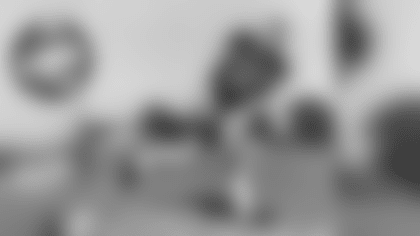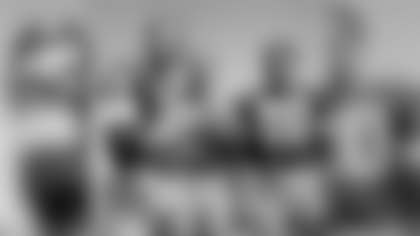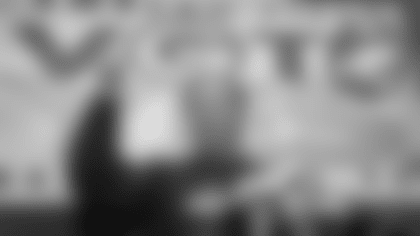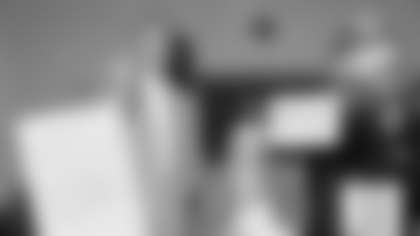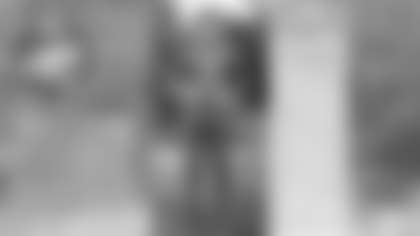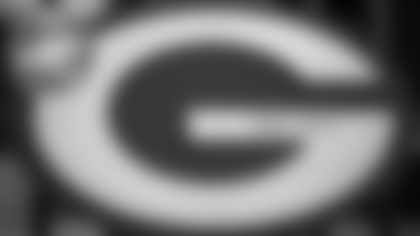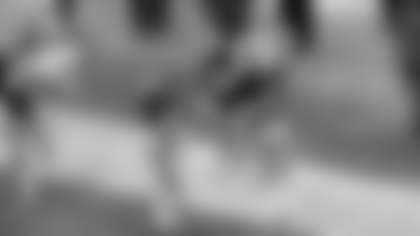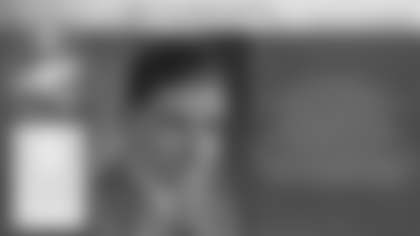Mike from Chicago
Looking at Vince Lombardi's drafts, there were a lot of misses, including in high rounds. But he seemed to make up for it in two ways. He always had additional choices by trading veterans a year early. Almost every player he traded for turned into a valuable contributor. One of the most memorable things you mentioned in an article was that Lombardi told his assistants and scouts, "Just show me if they've ever done it, and I'll get it out of them."
Like your question, so it's the only one I'm going to answer this week. But considering Lombardi never had a first-round choice higher than No. 5, and seven of his 13 No. 1s were taken between the 12th and 26th picks, I'd contend he drafted better than most people think.
Based on my research of the first 33 common drafts from 1967-99, among players selected with the first through fourth overall picks – something Lombardi was never in position to do – 23 percent have been inducted into the Pro Football Hall of Fame and 36 percent were named to at least one Associated Press All-Pro first team.
Of all the choices taken 12 through 26 over those 33 drafts, four percent are in the Hall of Fame and 11 percent made AP first team.
Here was my reasoning for cutting off the research after the 1999 draft. It was an ample sample size and also one that reduced the likelihood of significant changes in the percentages of Hall of Fame players. Far more players from the drafts since 2000 figure to be inducted into the Hall of Fame in the future compared to pre-2000 picks.
So let's live in the real world here, not the fantasyland of some internet scribblers.
Two of Lombardi's seven choices in that 12 through 26 range – or 29 percent – are in the hall and three of seven – or 43 percent – were first-team AP. That list includes Herb Adderley (12th overall, 1960), Dave Robinson (14th overall, 1963) and Gale Gillingham (13th overall, 1966).
Thus, Lombardi topped the standard.
Would you believe, for example, that over those 33 drafts, only one player selected in the 12th spot, Warren Sapp, is in the Hall of Fame? Only three have made AP All-Pro: halfback Chuck Foreman from the 1973 draft, tackle Jim Lachey in 1985 and Sapp.
Obviously, the odds vary from pick to pick but even with the No. 1 overall choice, only 11 – or 33 percent – ever made AP first team.
On the flip side, 40 percent of players drafted from 12 to 26 start for fewer than four seasons based on Pro Football Reference's quantifications for a starter. Among Lombardi's 13 No. 1 picks, only three fell into that category and one was halfback Tom Moore (fifth overall, 1960). And the only reason he started for only three seasons was that he played behind Paul Hornung. In 1963, when Hornung was suspended, Moore replaced him and was AP's second-team all-pro halfback.
The two others were indisputable busts.
One was flanker Larry Elkins, who was selected 10th in the 1965 NFL Draft, three spots after Lombardi chose halfback Donny Anderson with a pick acquired in a trade with Philadelphia. Elkins, who was the first overall choice in the American Football League draft, signed with the Houston Oilers, lasted two seasons and caught only 24 passes.
The other was quarterback Don Horn, selected 25th in the first common draft in 1967. He lasted four years in Green Bay and made only six starts, then bombed out in Denver after he was traded by Dan Devine.
But curiously, in 1969 under coach Phil Bengtson, Horn was 3-1 as a starter after the Packers had gone 5-5 in Bart Starr's starts. What's more, Horn finished the season with a team-record 410 yards passing in a 45-28 victory over the St. Louis Cardinals.
Yes, that was more yards than Arnie Herber, Cecil Isbell, Tobin Rote or Starr ever threw for in a game.
That's the great unknown here. How would some of Lombardi's later draft picks have panned out if they had played most or all of their careers for him?
For example, Lombardi was convinced after the 1967 Super Bowl season that Horn was going to be his quarterback of the future. In his only extensive opportunity as a rookie, a meaningless 24-17 loss in the regular-season finale, Horn completed 11 of 19 passes for 154 yards and produced all of the Packers' points while sharing playing time with Starr and Zeke Bratkowski.
Only a few days later and roughly three weeks before the Packers won Super Bowl II, Lombardi told Green Bay native Red Smith, the country's most widely syndicated sports columnist, that Horn was "destined to be as great as Bart Starr if not greater."
Who knows? Starr was 0-15-1 as a starter – not counting three wins by Babe Parilli in relief – when Lombardi inherited him.
There were other No. 1 choices by Lombardi who didn't make a splash in Green Bay but did elsewhere.
Fullback Earl Gros (14th overall, 1962) played nine years and rushed for 3,157 yards. While Gros never started a game in his two years in Green Bay because of the presence of Jim Taylor, he finished seventh in the NFL in rushing with 748 yards and a 4.9 average per carry in his first season after being traded to Philadelphia.
Lombardi also traded Lloyd Voss (13th overall, 1964) and he became a starting defensive lineman for Pittsburgh over the next six seasons. Bob Hyland (ninth overall, 1967) started nine games for the Packers in his first three seasons but couldn't prevail in his job competition with Packers Hall of Famer Ken Bowman. Hyland was traded and played seven more seasons elsewhere, including four as either a starting center or left guard for the Chicago Bears and New York Giants.
True, Gros, Voss and Hyland weren't stars. But they started a combined 208 NFL regular-season games.
Of Lombardi's nine second-round picks, the last three might be considered busts by most standards: defensive tackle Alphonse Dotson in 1965, offensive lineman Tom Cichowski as a future in 1966 and offensive end Dave Dunaway in 1967.
But even then, Dotson, after signing with Kansas City of the AFL, wound up playing in six postseason games with the Oakland Raiders over a five-year career. And Cichowski, after being waived by the Packers on the final cut in 1967, signed with the Broncos of the AFL, where he started nine games at offensive tackle as a late-arriving rookie before his career was derailed by a torn Achilles tendon in the second game of his second season.
Dunaway was a bust, no doubt about it. He caught two passes in a 13-game career.
But keep this in mind. He was selected 41st overall as a second-round choice in the first 25-team common draft. In 1958, when the Packers chose Jerry Kramer in the fourth round, as the last of their three future Pro Football Hall of Famers, he was the 39th overall pick.
No question, the Packers had several windfall drafts in the 1950s. Lombardi inherited 17 of the 22 starters on his first championship team, and 15 of them had been drafted by the Packers.
But back to reality. There were only 12 teams in the league in the 1950s, and because the Packers were perennial losers, eight of their 10 first-round picks from 1952-59 were top five choices. Twice they had two first-round picks: Nos. 3 and 4 in 1954, and Nos. 1 and 4 in 1957.
Pivoting again to Lombardi's drafts, he was responsible for acquiring 16 of the 22 starters in Super Bowl II, including 10 through the draft plus one as a rookie free agent, Willie Wood.
Lombardi's first-ever draft pick was Moore. Thereafter, the Packers' own No. 1s fell at 12, 14, 14, 13, 10, 13 and 25th. Lombardi also acquired three extra No. 1s from 1965-67 and they fell at 7, 9 and 9.
On top of the three Hall of Famers Lombardi was responsible for acquiring – Adderley, Robinson and Wood – he also drafted eight other Super Bowl II starters.
They were cornerback Bob Jeter (second round, 1960), defensive tackle Ron Kostelnik (second round, 1961), safety Tom Brown (second round, 1963), defensive end Lionel Aldridge (fourth round, 1963), tight end Marv Fleming (11th round, 1963), Bowman (eighth round, 1964), Anderson (first round with the pick obtained in the Jim Ringo trade, 1965) and Gillingham (first round, 1966).
Seven of the eight have been inducted into the Packers Hall of Fame.
In addition, halfback Elijah Pitts (13th round, 1961) and fullback Jim Grabowski (ninth overall, 1966) were the backfield tandem for the first eight games that year before they suffered season-ending injuries. And Hyland started the final six games of the regular season at center before Lombardi gave the job back to Bowman.
Not to be forgotten, either, was Travis Williams (fourth round, 1967).
If not for his heroics – an NFL record 41.1-yard average per kickoff return, including a record four touchdowns, as well as his 46-yard touchdown run in an upset of the Los Angeles Rams in the first playoff game – there may have been no Super Bowl appearance.
Plus, there were other choices who if not for injuries may have contributed even more to some of Lombardi's championship teams.
Moore led the NFL with a 33.1-yard kickoff return average as a rookie and was hailed by some as the second-best halfback in the league behind only Hornung during his first four seasons before suffering what was likely an undiagnosed stress fracture in his foot that never healed.
Linebacker Nelson Toburen (14th round, 1961) played in only 24 games before suffering a career-ending neck injury in his first pro start. But at least one observer who witnessed Toburen shutting up Ray Nitschke with an icy stare and a "---- you" in response to a locker-room demand thought he might not only beat the crap out of Nitschke on the spot but be a threat to his job.
In addition, three other draft picks were unable to crack the Packers' deep and talented roster but became starters for other teams, all within their first two seasons and eventually in championship games.
Halfback Ernie Green (14th round, 1962) couldn't beat out the threesome ahead of him – Hornung, Moore and Pitts – but was traded to Cleveland and started at halfback alongside Jim Brown for three years and then replaced him at fullback for two more. Along with starting for the Browns' last NFL championship team in 1964, Green also ranked third in all-time rushing to Brown and fellow Hall of Famer Leroy Kelly when he retired after the 1968 season.
Tackle Tony Liscio (third round, 1963) was waived by Lombardi on the final cutdown date of camp and signed by Dallas, where he played eight years and started 83 of 89 games. He was the starting left tackle for the Cowboys when they faced the Packers in the 1966 and '67 NFL Championship Games and also in their three postseason games when they won Super Bowl VI.
Cornerback Mike Bass (12th round, 1967) was sold to Detroit late in camp his rookie year and spent a season there on the taxi squad. In 1969, when Lombardi became coach of Washington, he signed Bass as a street free agent. Bass won the starting job at right cornerback in Lombardi's only season there and held it for seven years, starting six postseason games under Hall of Fame coach George Allen, including Super Bowl VII. In fact, Bass started every regular-season and postseason game from 1969-75.
John Rowser (third round, 1967) played opposite Bass at Michigan and spent three years with the Packers as a backup corner before being traded to Pittsburgh in 1970. Although Bass turned out to be the better player, Rowser was a starter on Chuck Noll's first two playoff teams in Pittsburgh. In all, Rowser started 79 of his 85 games over seven seasons with the Steelers and Broncos.
At two other areas where Lombardi was looking to replace veteran starters in his final seasons in Green Bay, it never happened partly because of draft picks lost to the then rival AFL.
One was the offensive line and not just with Bowman taking over for Ringo and Gillingham unseating Fuzzy Thurston. As early as 1964, Lombardi was looking to relieve Thurston and maybe even Kramer of their jobs. Thus, Dan Grimm (fifth round, 1963) started 12 games that year at right and left guard; and Steve Wright (fifth round, 1964) started 12 at right tackle in 1965 with Forrest Gregg moving to guard.
One can only wonder what the makeup of the offensive line might have been in 1967 if the Packers had not lost three high draft picks in 1964 – all linemen – to the AFL. Conceivably, at least one or two of them might have been good enough to start for Lombardi by then.
Center Jon Morris (second round, 1964) signed with the then Boston Patriots and played in six AFL All-Star Games and the first Pro Bowl following the merger over his 15-year career. He's the only center in the Patriots Hall of Fame and also was named the center on their 50th anniversary team.
Joe O'Donnell (third round, 1964) signed with Buffalo and made his first pro start in the 1965 AFL Championship Game. The Bills beat San Diego, 23-0, and their offensive line nullified what was arguably the AFL's best front four, featuring end Earl Faison and tackle Ernie Ladd. With that notch in his belt, O'Donnell took over as the Bills' starting right guard for four of the next five seasons, missing one with a knee injury.
Paul Costa (fourth round, 1964) was listed as a 6-foot-4, 230-pound halfback at Notre Dame when the Packers drafted him as a future but then moved to defensive end his senior year. He signed with the Bills before the 1965 season and made his third position switch in three years. After taking over as their starting tight end midway through the season, averaging 19.1 yards per catch, and then playing four years there, Costa moved to right tackle, where he started for most of the next four seasons.
Guard Len St. Jean (17th round, 1964) also signed with the Patriots the same year as Morris and started 112 of 140 games over the next 10 seasons.
By 1963, when Lombardi drafted Dennis Claridge of Nebraska in the third round, he was looking to find Starr's eventual successor. Claridge didn't pan out, but Lombardi selected a second quarterback in the 12th round that year who certainly had the talent to be Starr's replacement.
However, Notre Dame's Daryle Lamonica signed with the Bills and wound up in Oakland, where he led the Raiders to a 13-1 record in his first year as a starter and faced the Packers in Super Bowl II. Nicknamed the "Mad Bomber," Lamonica played eight years with the Raiders and compiled a 62-16-6 record as a starting quarterback and was twice MVP of the AFL.
In fact, before Super Bowl II, George Wilson, who had faced Lamonica that season as coach of the Miami Dolphins and Starr 13 times as coach of the Lions from 1957-64, said, "I believe the two hottest quarterbacks in professional football through the season were Sonny Jurgensen with the Redskins and Lamonica in our league."
Considering Lombardi relished the challenge of coaching raw and rare talent, while also believing that the most important moves in the quest for sustained success were getting rid of players, it's possible that if the Packers had signed Lamonica out of college he would have been their starting quarterback by 1967.
Starr outplayed Lamonica in the Super Bowl but was seven years older and couldn't match his arm strength.
"There are two quarterbacks who started six or more seasons who have over an .800 winning percentage," Ron Wolf, who was player personnel director during his first stint with the Raiders from 1963-75, told me a month ago. "They are Otto Graham and Daryle Lamonica – that is all!
"Daryle had it tough with the Raiders later on because of the influence of George Blanda and the development of Ken Stabler. Stabler fit more into what (John) Madden preferred. In talking to Blanda after his retirement, he told me that Daryle should be in the Hall of Fame."
Blanda played an NFL record 26 seasons as a quarterback and kicker, and was inducted into the Hall of Fame in 1981. And I should also note that Lamonica's regular-season winning percentage was .784, but it was close enough for Wolf's point to be well taken.
Although Green, Liscio, Bass, Rowser, Morris, O'Donnell, Costa, St. Jean and Lamonica never appeared in a game for the Packers, they were nine good to outstanding draft picks.

The chart above is what could have been the Packers' starting lineup in 1968, the year Lombardi was general manager and they suffered a 6-7-1 record under Bengtson.
Give Lombardi that team, and my bet would be that it would have been a Super Bowl contender that season and maybe for many more if he had lived.
A few notes on my selections.
Thirty-four-year-old left tackle Bob Skoronski and 32-year-old right guard Jerry Kramer played well in 1968, but they both retired after that season and Lombardi had talked openly after Super Bowl II about it being time to refurbish his lineup with youth.
Defensive end Willie Davis and defensive tackle Henry Jordan each played two more seasons before retiring at ages 35 and 34, respectively. By 1968, Jordan was on the downside due to back problems.
Two positions where the Packers urgently needed better heirs apparent were defensive end and wide receiver.
Their scouting department had found the answers. The Packers drafted future Pro Football Hall of Fame defensive lineman Buck Buchanan in the 17th round in 1962, but the NFL decided he didn't qualify as a future and voided the pick. The next year, the then Dallas Texans – and soon-to-be Kansas City Chiefs – selected him as the No. 1 overall choice in the AFL draft and signed him immediately.
In 1965, the Packers entered the draft with the hope of nabbing wide receiver Otis Taylor with the seventh overall choice but couldn't locate him because the Chiefs were in the process of signing him. Entering Super Bowl I, the two Chiefs the Packers game-planned to nullify were Taylor on offense and Buchanan on defense.
Put those two players on the 1968 Packers and they might have been heavy favorites for a four-peat.
Another option at flanker, where Dowler and Dale were both over 30, would have been Anderson if Williams hadn't succumbed to the personal problems that short-circuited his career. Some of the Packers' coaches and personnel people – and perhaps even Lombardi himself – thought Anderson's best position was flanker.
One more year and it would have been time to replace Gregg with 1968 third-round choice Dick Himes and Lee Roy Caffey with 1968 No. 1 pick Fred Carr, a future three-time Pro Bowl linebacker and another outstanding choice by Lombardi.
Replacing Nitschke at middle linebacker in another year or so was another must-do.






